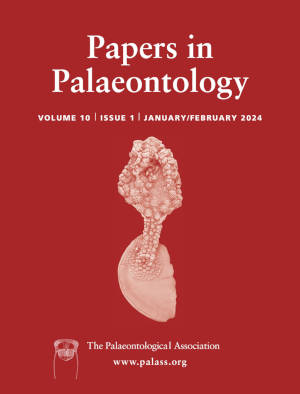Article: Late Ordovician and early Silurian virgianid and stricklandioid brachiopods from North Greenland: implications for a warm-water faunal province
Publication: Papers in Palaeontology
Volume:
10
Part:
1
Publication Date:
2024
Article number:
e1544
Author(s):
Jisuo Jin, Christian M. O. Rasmussen, Peter M. Sheehan, and David A. T. Harper
DOI:
10.1002/spp2.1544
Abstract
Abstract An unusually rich and diverse suite of virgianid brachiopods, hitherto poorly known, is systematically described here for the first time from the Ordovician–Silurian boundary interval (late Katian – Aeronian) of North Greenland. The Late Ordovician virgianids comprise typical taxa of the warm-water Tcherskidium fauna (e.g. Tcherskidium tenuicostatum, Proconchidium schleyi, Holorhynchus giganteus and Deloprosopus dawesi sp. nov.). Among the early Silurian taxa, Virgiana hursti sp. nov. occurs as abundant shell beds, similar to other congeneric species in Laurentia, but has somewhat larger internal skeletal structures, albeit not as extravagantly developed as in the late Katian virgianids; Borealoides balderi gen. et sp. nov. shows extreme thickening of the shell wall and internal structures, approaching the extravagant calcification of Katian virgianids. The highly distinctive mid-Aeronian stricklandioid brachiopod genus, Kulumbella, characterized by a shell with criss-cross (divaricate) ribbing, also occurs in North Greenland, represented by K. heimdali sp. nov., which has the largest and most strongly biconvex shells for the genus. Palaeogeographically, the Late Ordovician virgianid fauna of Laurentia was highly distinct, confined to the low–mid tropical latitudes north of the palaeoequator. In comparison, the early Silurian (Rhuddanian) Virgiana and some related taxa in Laurentia spanned the tropics of both hemispheres, forming extensive shell beds in carbonate basins, although Borealis and Borealoides gen. nov. remained confined largely to the northern hemisphere, suggesting a certain level of provincialism extending into the earliest Silurian. A palaeoecological preference for warm-water carbonate settings would explain the unusual abundance and richness of the virgianid faunas in North Greenland.
